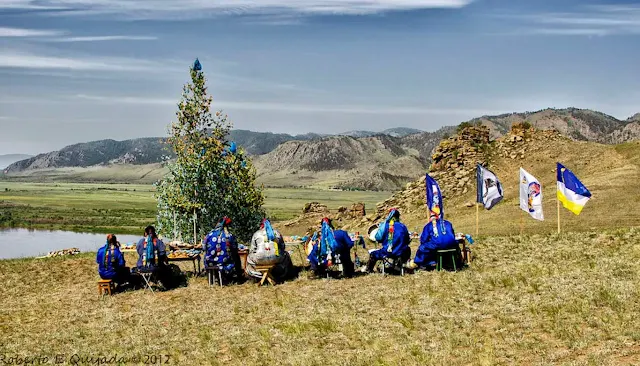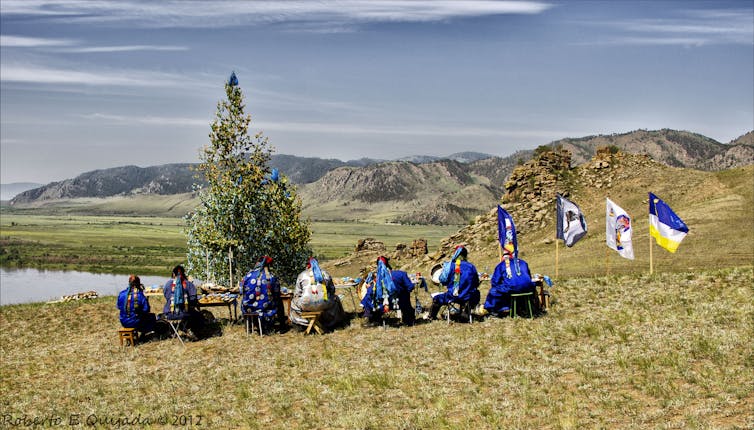I have just written about a philosophy or religion or even a concept called "animism". It's hard to know what it actually is. I think it is a type of religion, but it is very far from the conventional religions of the West such as Christianity in which people worship a man. Christianity seems to be sexist to me. And I think that Christianity has left a terrible legacy to the world.
 |
| Shamans from the organization Tengeri conduct an offering ritual in 2013. Image: see bottom left. |
Through the bible, Christianity preached and continues to preach that humankind has dominion over the rest of the world including all animals. That's at least partly why, I argue, there is mass and endemic animal abuse across the planet and has been for centuries. An also who sport hunters have no empathy with animals. It is completely missing.
And that is why humans think they can control and abuse nature to their own commercial ends.
But nature is striking back with global warming. And if everybody on the planet believed in animism, we wouldn't have global warming. Animism is respectful of nature, the landscape, the mountains and all these inanimate objects which are given souls by animism. They almost become sentient. They are part of our lives. They support us.
RELATED: Justice for Strushie-Miami Beach cat killed by arrow. Karma and updates.
Animism believes that nature is more powerful than people. The landscape has dominion over people. People have a place within the landscape, within nature and the world. This forces people to be more respectful of inanimate objects and animate objects other than themselves.
It is hard to know whether it is a religion or not. It is certainly a belief system as I would call it. It appears that ancient tribal people tucked away in some far-flung lands are far more predisposed to believing in animism than the technocrats and capitalists of the West.
Technology seems to me to present a barrier between people and nature. Technology too dry. It lacks spirit. But if a person opens their mind and walks into a forest and tries to commune with nature i.e., talk to the trees, they will talk back. It's a question of being open-minded and 'feeling' nature.
Sadly, most people are so distanced from nature that they have lost contact with it completely. They won't understand animism at all. There are far more likely to understand football and the latest smart phone.
There is a distinct place in the modern world for animism. It is a growing philosophy or religion, and this is timely because the destruction of the planet by humankind would not have happened if there was a greater belief in it.
When people visit fantastic landscapes and sit within that landscape and contemplate or meditate, I believe that they can feel nature and in feeling nature they are practising the religion of animism even if they are unaware of it. That is my interpretation.
A person with a far more knowledgeable approach to animism is Justine Buck Quijada. She is an associate Prof, Department of Religion, Wesleyan University.
I think she sums up animism quite nicely in the following words written by her on The Conversation website:
"Instead of human dominion over the landscape, in animist cosmologies, humans live under the dominion of the landscape around them."
Her article from which I formed my thoughts is available for republishing under a Creative Commons licence and therefore I've taken the liberty, something I would never do normally, to republish it below. It should be interesting to many people who are concerned about the planet, nature and animal welfare.
‘Animism’ recognizes how animals, places and plants have power over humans – and it’s finding renewed interest around the world

A movement known as “new animism,” which seeks to secure personhood rights for nonhuman beings through legal means, is gaining a following around the globe.
New animist environmental activists are not the only ones using the term. Animism itself has become fashionable. Some spirituality bloggers talk about animism as a way to deepen one’s spiritual relationship to nature. Scholars – from anthropologists to philosophers – have taken a renewed interest in the concept.
Most of these people are using animism in a very general, and inaccurate, way, to mean the belief that everything in nature has a soul. The renewed interest in animism stems from the hope that people will behave in more ecologically sustainable ways if they believe that the natural world around them is alive.
However, as an anthropologist of religion who works with people whose religious practices were traditionally described as animist, I believe the reality is both more interesting and more complicated. Animism is not a religion or even a set of beliefs about nature having a soul. It’s a term used by scholars to classify religious practices through which human beings cultivate relationships with more powerful beings that reside in the world around us.
A history of the term
The term animism was coined by an early anthropologist, Edward Burnett Tylor, in 1870. Tylor argued that Darwin’s ideas of evolution could be applied to human societies; he classified religions according to their level of development.
He defined animism as a belief in souls: the existence of human souls after death, but also the belief that entities Western perspectives deemed inanimate, like mountains, rivers and trees, had souls.
Animism was, in Tylor’s view, the first stage in the evolution of religion, which developed from animism to polytheism and then to monotheism, which was the most “civilized” form of religion. From this perspective, animism was the most primitive kind of religion, while European, Protestant Christianity was seen as the most evolved of all religions.
Tylor was not the first to make this argument. Scottish philosopher David Hume, for example, made a very similar argument in the “Natural History of Religion,” in 1757. Tylor was, however, the first to use the term animism and the classification scheme as part of what was then the nascent field of anthropology, the scientific study of human society.
Animism is therefore not a religion but a term for classifying a type of religion, one which was, in the 1870s at least, deemed by European and American scholars to be less civilized. The racist conception that some groups of people were less civilized than others was integral to the initial definition.
Around the turn of the 19th century, scholars used Tylor’s term to classify a wide array of rituals. James Frazer and Geza Roheim, for example, used animism to argue for similarities among the practices of Indigenous populations, ancient Greeks and European peasants. Animism was used to describe the psychology of Native Americans and Siberian shamans asking spirit masters to offer up game to hunters. By the 1940s, however, the term, and the practice of classifying cultures by their level of development, had fallen out of favor.
Why, then, are environmental activists embracing a term with this complicated history?
An alternative to ‘dominion’
In 1967, historian Lynn White Jr., himself a devout Christian, argued that the world’s environmental problems came from Christian dominion theology. In this reading of the biblical account of Genesis, humans are the only part of creation that is made in the image of God, which is usually interpreted to mean that humans, unlike all else in creation, have souls.
This theology gives humans – through Adam and Eve – dominion over the Earth. White argued that through its creation story, Christianity set up a dichotomy between inanimate matter and animate spirit that lifts humans above creation and turns the rest of the world – from animals and plants to rocks, soil and water – into “resources” to be used.
It is important to note that this is only one of many Christian interpretations of Genesis. On the other hand, White’s argument was that this idea of dominion is what makes environmental exploitation under capitalism possible, and that argument was compelling to many environmentalists, who began to develop an interest in Indigenous belief systems as a way to fix environmental problems.
Relationships of power and obligation
What is important to understand about animism is that it is not a religion per se, nor is it a matter of merely believing that a mountain or a glacier has a soul. Animism describes practices that establish a relationship between places and people, usually one that recognizes places, animals and plants have power over people.

I study the way urban Buryats, members of an Indigenous population of Siberia, are reviving pre-Soviet forms of animism and shamanism. Many of their rituals involve asking for blessings and protection from beings such as rivers, lakes and mountains, and from ancestors who are located in the landscape – all practices that create relationships of obligation between people and place.
There is a wide range of practices that contemporary scholars consider to be animist, ranging from rules about what you can and cannot do near a glacier and making offerings to the spirit masters of Lake Baikal to representing the will of mountains in political negotiations.
In all these instances, rituals establish relationships of obligation that tie humans to the land, and the land to the humans who live on it. Instead of human dominion over the landscape, in animist cosmologies, humans live under the dominion of the landscape around them.
No magic bullet
Animism is not a religion one can convert to but rather a label used for worldviews and practices that acknowledge relationships between nature and the animal world that have power over humans and must be respected.
These practices can be religious rituals, but they can also be forms of environmental care, farming practices or protests, such as those conducted by the water protectors at Standing Rock, known as the No Dakota Access Pipeline, also called by the hashtag #NoDAPL. Protests like the #NoDAPL aren’t what most people are used to thinking of as “religion,” and, as a result, media accounts often miss the obligations to place and land that motivate protesters.
New Zealand’s 2017 act recognizing the Whanganui River as a legal person, the culmination of decades of Maori activism, could be described as animism taking a legal form. Additionally, when Indigenous practices are labeled animist religion, it is easy to overlook the very real biological and ecological scientific knowledge of these communities.
Animist practices are as variable as the peoples and places engaging in such relationships. Indigenous and animist perspectives illustrate that there are many different relationships possible between humans and the world around them, and many environmentalists are finding these alternatives instructive, despite the troubled history of the term.![]()
Justine Buck Quijada, Associate Professor, Department of Religion, Wesleyan University
This article is republished from The Conversation under a Creative Commons license. Read the original article.



ليست هناك تعليقات:
إرسال تعليق
Your comments are always welcome.